Latest concept design for K3 came out and I felt it is good time to post general summary on the development of the tank.

Shown in the background, visual image suggest it will use 130mm gun, and has cockpit module similar to Russian T-14 Armata.
History
The goal of the XK3 project is to maintain tank fleet around 2000 according to Defense Plan 2030. For more detail about Defense Plan 2030, please go to https://csis.org/publication/evolving-military-balance-korean-peninsula-and-northeast-asia
for free PDF file. By 2030, original K1 fleet would have been in service for about 45 years and need to retired. The goal to have a new tank in 2030 reflect similar projects of the US and Germany, FMBT with former and joint Franco-German project with the latter.
Armament
- Comparison of the modern tank guns
In XK3, the Korean military will research on rail gun or electro thermal-chemical gun, with remote turret with new generation of FCS. Electro thermal-chemical research was already pursued by Agency of Defense Development (RoK military R&D) when XK3 project is announced. The research began as soon as K2 entered production with intent goal to upgrade K2 with it. Goal of the research is to have gun that can fire APFSDS over 2100m/s and penetrating power of 1000mm at 1000m.
Research on rail gun by ADD began in 1989, in 1990 made first test, able to propel 1 gram of projectile with speed of
3400m/s.
- History of Electro Chemical and Railgun development

1989-1990
In joint development with Seoul National University and Agency of Defense Development (South Korean military R&D), a 10mm railgun was developed using 300 Kj bank module capacitor which is capable of firing 1.3g of projectile at speed of 4.3km/s.
1992-1997
Continuing from previous project with SNU, a 20mm electrothermal-chemical gun was developed using two 600 Kj bank module capacitors with each capacitor compose of twelve 50kj capacitors. 107g projectile was fired at speed of 1.24km/s.
1998 - 2006
A 30mm electrothermal-chemical gun was tested with 2.4MJ Pulse Forming Network, composed of eight 300KJ modules. This platform test breechblock and recoil brake.
2007 - 2009
120mm electrothermal-chemical gun was tested using 150kj compact capacitive pulse power system, composed of four 37.5kj capacitor module. Capable of firing 4 to 5 times before recharge. At 82KJ, it could has breech pressure of 724MPa(105007 psi) with projectile speed of 1792m/s.
Note: US M256 120mm (Rheinmetall L44) gun mounted on M1 fleet has breech pressure of 630MPa(91373psi) and muzzle velocity of 1580m/s. Rheinmetall 120mm L/55 gun has breech pressure of 580MPa(84122psi) and muzzle velocity of 1750m/s.
2009-2011
A 25mm railgun tested using 2.4MJ pulse forming network from 30mm electrothermal-chemical gun.
2011-2014
40mm railgun was tested using two 2.4MJ PFN. The caliber is 40mm by 50mm, barrel length is 5.6m. It can discharge 300g of projectile at speed of 2 to 2.5km/s.
Note: Bofor 40mm/L70 has muzzle velocity of 1021 m/s and 40mm/L60 has 881 m/s.
2015- Current
A medium caliber railgun is being developed.
Second hand video of railgun test firing:
View: https://youtu.be/cGyWwQcH0tA
Armor
In early nineties, RoK procure several T-72 from Eastern Bloc and T-80U directly from Russia. RoK military was shocked that T-80U's 3BM42 APFSDS can penetrate 550mm at 1000m. This is further compounded by unsubstantiated news that DPRK was planning to procure 200 T-72 equipped with ERA. This spur the development of K1A1 and second generation of composite armor known as Korean Special Armour Plate (KSAP).
Original K1, equipped with Special Armour Plate, which is based on Chobham composite armor, was refitted with KSAP. K2 is fitted with third generation of composite armor with ERA and Non-Explosive Reactive Armor (NERA).
With XK3, Korea will research on Stealth technology(cloaking?), electromagnetic protection(force field?) and composite
armor.
-Electromagnetic Armor
Detail on this project is sparse but United Kingdom and US is known to pursuing the development. Here is brief news video that discuss the concept:
View: https://youtu.be/o7rxBifd0cY
Alternate sources for videos:
Link1
Link2
Early Concepts

Counter clockwise from the top:
- independent commander targeting system
- direct energy weapon
- high efficient electric propulsion system
- active response defense system
- 360 degree situation awareness system
- vehicle mounted drone system
- vehicle rescue system and force field system
- smart wheel system
- flexible rubber track
- unified crew compartment
- mine and ied detection system
- grenade launcher
- somekind of energy road detection system
- railgun
- automatic unmanned turret.
Following concept design, which shows strong influence of Polish concept tank:

- 360 degree detector
- anti IED system
- Multipurpose missiles
- Smoke grenade launchers
- 360 degree radar
- Multipurpose drone
- ERA
- Active Brake Assist
- Bend Track
- 130mm gun or electrothermal chemical gun
- Capsule Crew Cockpit
- Pilot Camera
- Active Protection System
- Laser gun
- Autoloader

SOURCE:
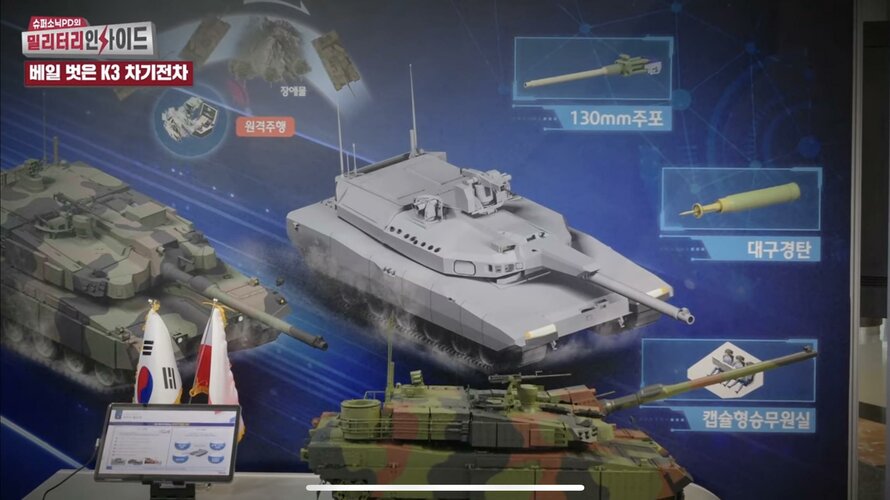
Shown in the background, visual image suggest it will use 130mm gun, and has cockpit module similar to Russian T-14 Armata.
History
The goal of the XK3 project is to maintain tank fleet around 2000 according to Defense Plan 2030. For more detail about Defense Plan 2030, please go to https://csis.org/publication/evolving-military-balance-korean-peninsula-and-northeast-asia
for free PDF file. By 2030, original K1 fleet would have been in service for about 45 years and need to retired. The goal to have a new tank in 2030 reflect similar projects of the US and Germany, FMBT with former and joint Franco-German project with the latter.
Armament
- Comparison of the modern tank guns
- US M829A3 APFSDS, when fired from 44 calibre at 1555m/s can penetrate 800 to 900mm at 2000m.
- German DM63 APFSDS, when fired from 55 calibre at 1750m/s at 2000m, can penetrate 700 to 750 mm.
- 3BM42M APFSDS at 2000 meters can penetrate 600 to 650 mm, when fired from T-90A at 1700m/s.
- T-14's 2A82-1M gun can fire 15 to 20% more pound per square inch then its predecesor, 2A45M with superior range.
- Basic 105mm APFSDS for RoK military is K274, which can penetrate 470mm. Latest version K274N can penetrate 550 to 600 mm.
- K1A1 is equipped with 44 calibre 120mm gun modeled after Rheinmetal 44 calibre 120mm gun with 74,000 psi.
- K2 was originally planned to be fitted with 140mm gun, but instead chose 55 calibre 120mm gun with 97,000 psi.
In XK3, the Korean military will research on rail gun or electro thermal-chemical gun, with remote turret with new generation of FCS. Electro thermal-chemical research was already pursued by Agency of Defense Development (RoK military R&D) when XK3 project is announced. The research began as soon as K2 entered production with intent goal to upgrade K2 with it. Goal of the research is to have gun that can fire APFSDS over 2100m/s and penetrating power of 1000mm at 1000m.
Research on rail gun by ADD began in 1989, in 1990 made first test, able to propel 1 gram of projectile with speed of
3400m/s.
- History of Electro Chemical and Railgun development
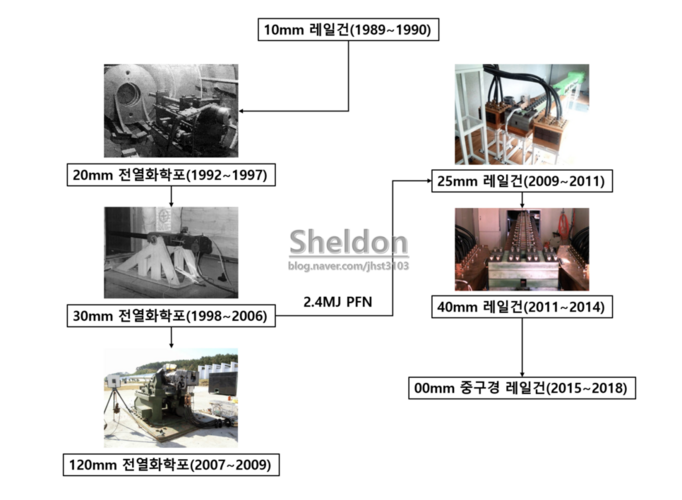
1989-1990
In joint development with Seoul National University and Agency of Defense Development (South Korean military R&D), a 10mm railgun was developed using 300 Kj bank module capacitor which is capable of firing 1.3g of projectile at speed of 4.3km/s.
1992-1997
Continuing from previous project with SNU, a 20mm electrothermal-chemical gun was developed using two 600 Kj bank module capacitors with each capacitor compose of twelve 50kj capacitors. 107g projectile was fired at speed of 1.24km/s.
1998 - 2006
A 30mm electrothermal-chemical gun was tested with 2.4MJ Pulse Forming Network, composed of eight 300KJ modules. This platform test breechblock and recoil brake.
2007 - 2009
120mm electrothermal-chemical gun was tested using 150kj compact capacitive pulse power system, composed of four 37.5kj capacitor module. Capable of firing 4 to 5 times before recharge. At 82KJ, it could has breech pressure of 724MPa(105007 psi) with projectile speed of 1792m/s.
Note: US M256 120mm (Rheinmetall L44) gun mounted on M1 fleet has breech pressure of 630MPa(91373psi) and muzzle velocity of 1580m/s. Rheinmetall 120mm L/55 gun has breech pressure of 580MPa(84122psi) and muzzle velocity of 1750m/s.
2009-2011
A 25mm railgun tested using 2.4MJ pulse forming network from 30mm electrothermal-chemical gun.
2011-2014
40mm railgun was tested using two 2.4MJ PFN. The caliber is 40mm by 50mm, barrel length is 5.6m. It can discharge 300g of projectile at speed of 2 to 2.5km/s.
Note: Bofor 40mm/L70 has muzzle velocity of 1021 m/s and 40mm/L60 has 881 m/s.
2015- Current
A medium caliber railgun is being developed.
Second hand video of railgun test firing:
Armor
In early nineties, RoK procure several T-72 from Eastern Bloc and T-80U directly from Russia. RoK military was shocked that T-80U's 3BM42 APFSDS can penetrate 550mm at 1000m. This is further compounded by unsubstantiated news that DPRK was planning to procure 200 T-72 equipped with ERA. This spur the development of K1A1 and second generation of composite armor known as Korean Special Armour Plate (KSAP).
Original K1, equipped with Special Armour Plate, which is based on Chobham composite armor, was refitted with KSAP. K2 is fitted with third generation of composite armor with ERA and Non-Explosive Reactive Armor (NERA).
With XK3, Korea will research on Stealth technology(cloaking?), electromagnetic protection(force field?) and composite
armor.
-Electromagnetic Armor
Detail on this project is sparse but United Kingdom and US is known to pursuing the development. Here is brief news video that discuss the concept:
Alternate sources for videos:
Link1
Link2
Early Concepts
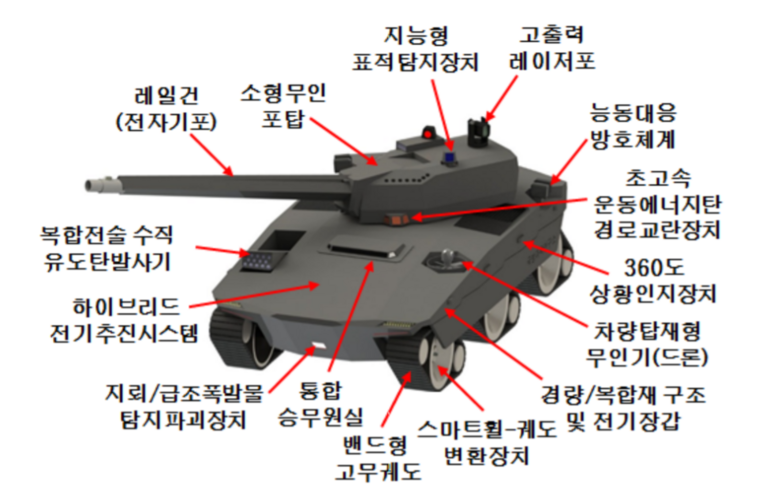
Counter clockwise from the top:
- independent commander targeting system
- direct energy weapon
- high efficient electric propulsion system
- active response defense system
- 360 degree situation awareness system
- vehicle mounted drone system
- vehicle rescue system and force field system
- smart wheel system
- flexible rubber track
- unified crew compartment
- mine and ied detection system
- grenade launcher
- somekind of energy road detection system
- railgun
- automatic unmanned turret.
Following concept design, which shows strong influence of Polish concept tank:
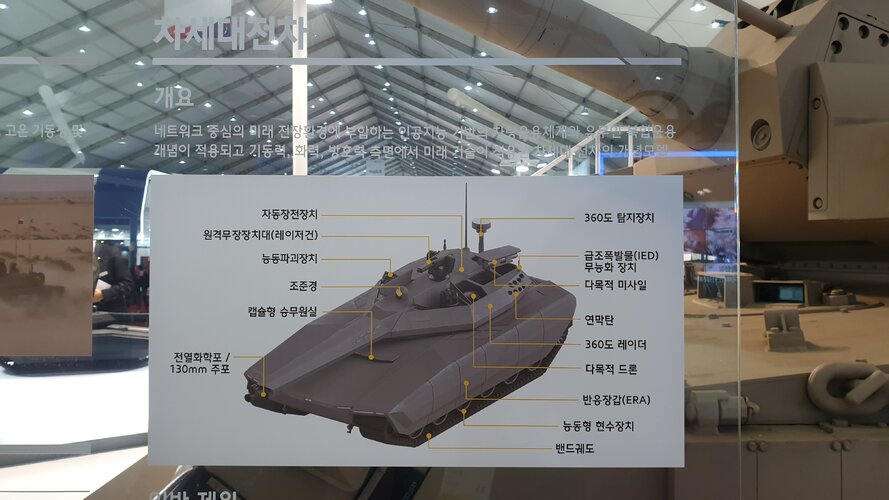
- 360 degree detector
- anti IED system
- Multipurpose missiles
- Smoke grenade launchers
- 360 degree radar
- Multipurpose drone
- ERA
- Active Brake Assist
- Bend Track
- 130mm gun or electrothermal chemical gun
- Capsule Crew Cockpit
- Pilot Camera
- Active Protection System
- Laser gun
- Autoloader
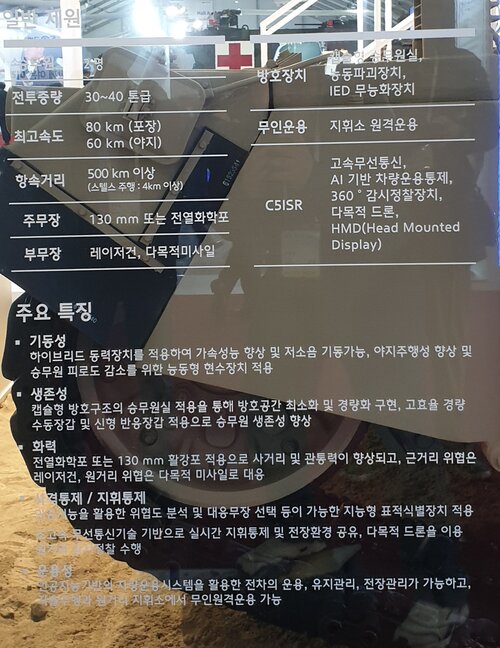
| Left Top Column: Crew - 2 Combat Weight - 30 to 40 tons Speed: 80 km while on top speed and 60km on maintain speed Maximum range: 500 km, stealth mode 4km Primary armament: 130mm or electrothermal-chemical gun Secondary armament: Lasergun and multipurpose missile | Right Top Column: Defense System - Capsule Crew Compartment, Active Protective System, Anti IED Remote Control - Direct control from HQ C5ISR - HF radio, AI basic transportation, 360 degree surveillance, multipurpose drone, helmet mounted display |
| Mobility - Hybrid transmission that provide various mode of speed and crew comfort Safety - Crew capsule, combined with composite armor and new generation ERA Firepower - 130mm gun or electrothermal-chemical gun, with laser gun and multipurpose missile Fire Control & Command and Control - automated fire control and various command and control feature including drone Remote control from HQ. |
SOURCE:
- http://www.kyobobook.co.kr/product/...Gb=KOR&barcode=3904000144917&orderClick=LAA#N
- https://en.wikipedia.org/wiki/Electrothermal-chemical_technology
- https://en.wikipedia.org/wiki/Railgun
- https://blog.naver.com/jhst3103/221201128287
- https://en.wikipedia.org/wiki/Electric_armour
- https://forums.spacebattles.com/threads/south-korea-xk3.349064/
- https://blog.naver.com/jhst3103/221268777991
- https://milidom.net/index.php?mid=photo&page=2&document_srl=1159771
